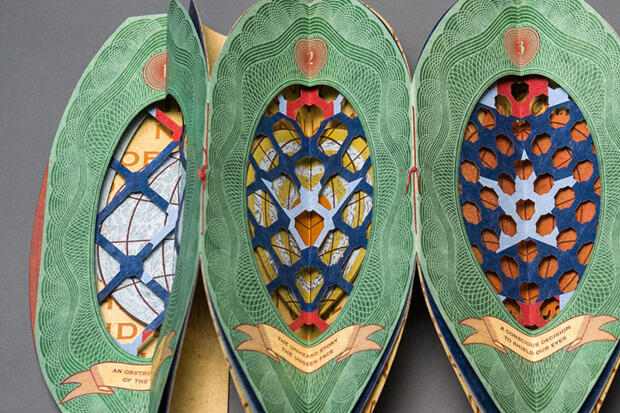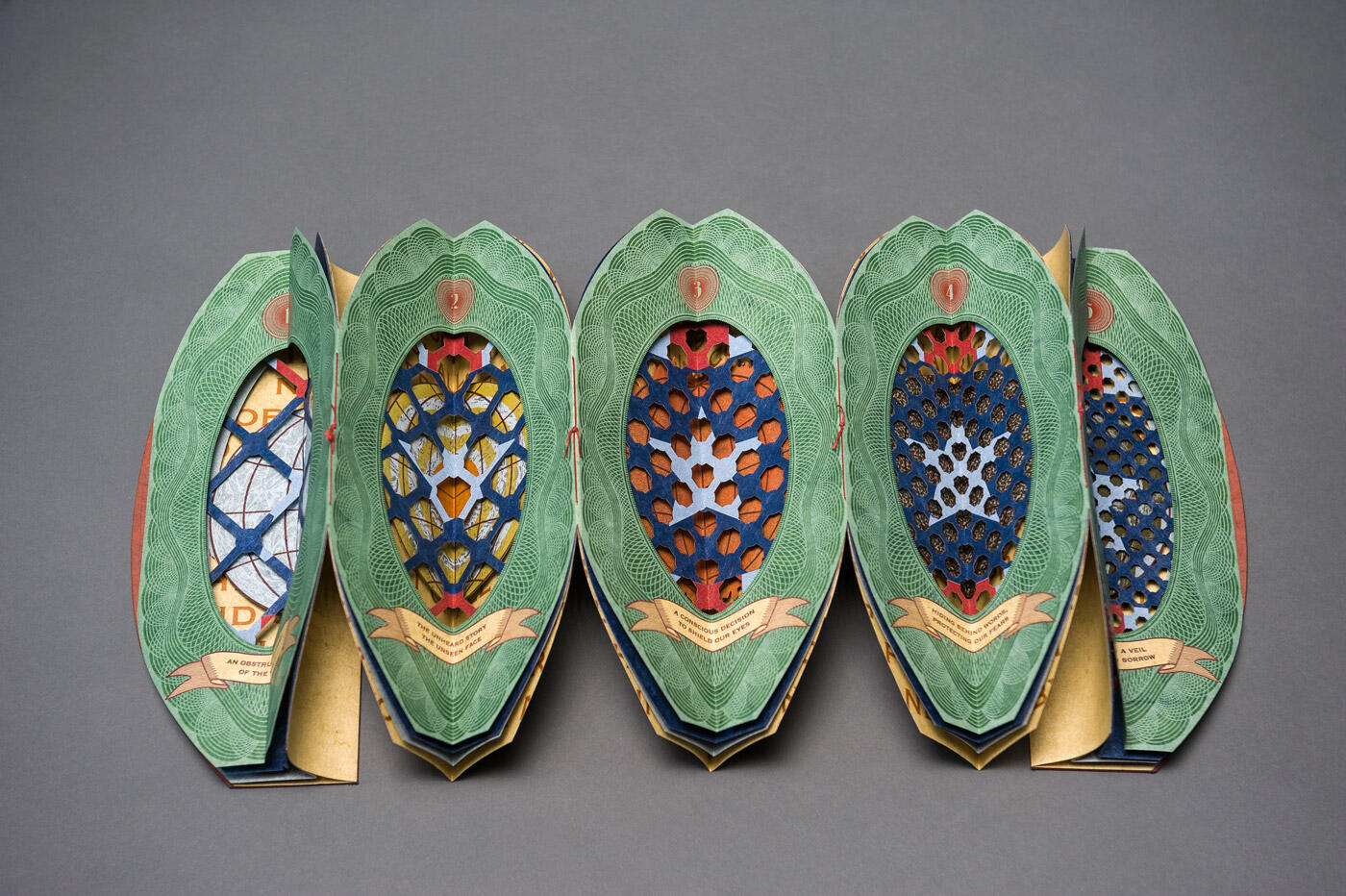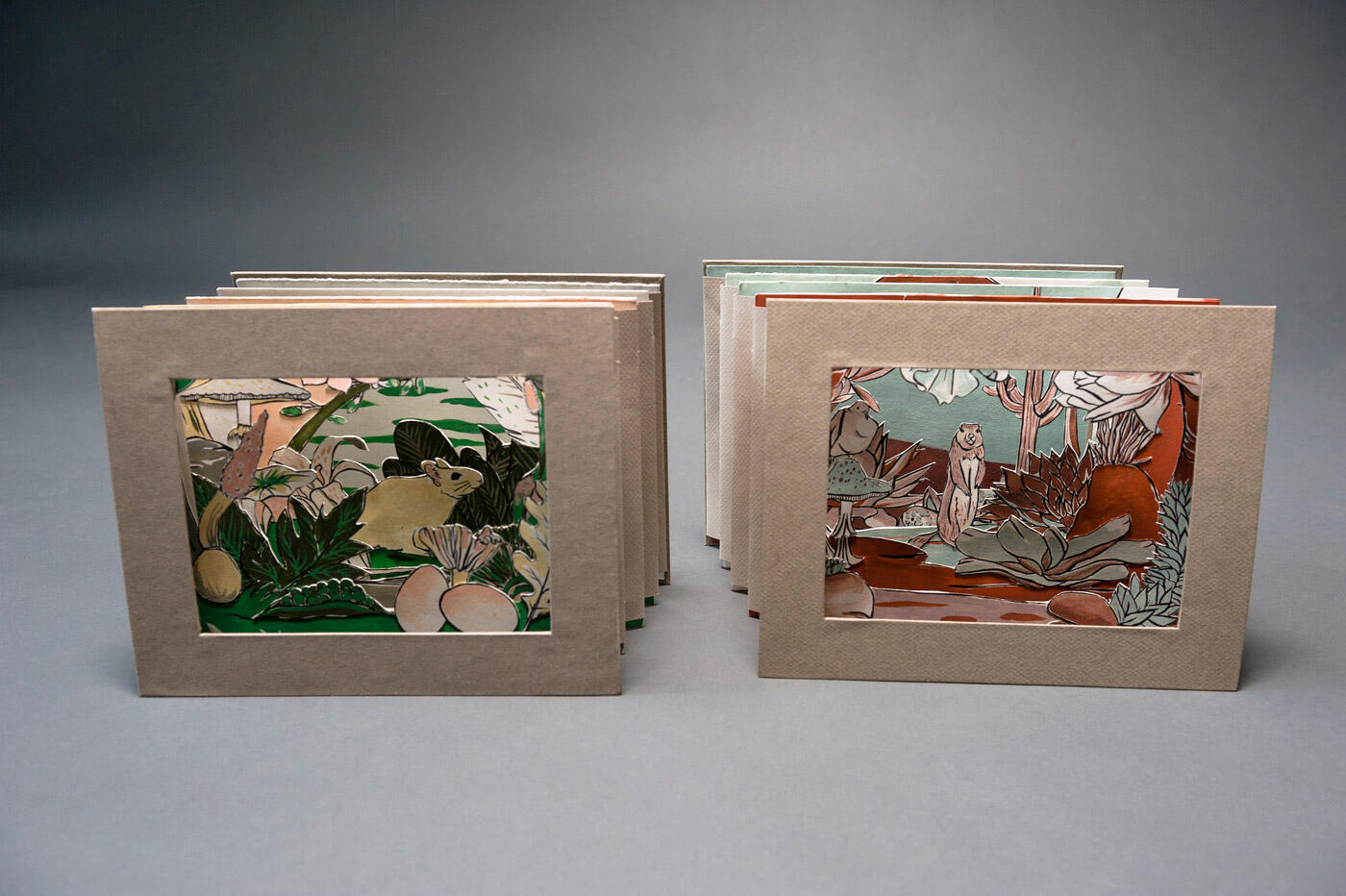
May 22, 2015
More than words: 16 of the most interesting and unusual items in VCU's Book Art Collection
Share this story
A book carved into the shape of a handgun. A pop-up book that unfolds into a colorful explosion of Chinese food. A double-page spread depicting a forest scene that appears only under ultraviolet light. A hand-embroidered composition notebook that meditates on the etymology of words.
These “artists’ books” — or works of art that borrow from the form of the book — are all part of the Virginia Commonwealth University Book Art Collection, which contains more than 4,000 pieces housed in VCU Libraries’ Special Collections and Archives at James Branch Cabell Library.
“Artists’ books borrow from the form of the book in that they’re works of art that usually have some sort of a sequence, often focusing on the development of an idea or message or narrative,” said Yuki Hibben, assistant head of Special Collections and Archives. “They’re published in small editions. Some are unique.”
Each year, approximately 60 classes, mostly from the School of the Arts, visit the collection for assignments, projects and research. But the collection isn’t limited to use by VCU students and faculty. VCU Libraries welcomes visitors from the community and beyond to experience the books with their own hands.
“These books provide the viewer with a sense of discovery,” Hibben said. “They offer very intimate experiences, in terms of the viewer looking at the artwork. It’s not like standing in a gallery, looking at a painting or sculpture with multiple people.
Hibben and Leila Prasertwaitaya, a library specialist for the arts in Special Collections and Archives, recently showcased some of the most fascinating – and most unusual – artists’ books in the Book Art Collection.

“Cuff: Sugar and Spice,” 2008
by Allison Cooke Brown
“Cuff,” which is shaped like a cuff that might be found on a woman’s Renaissance dress, features bound fabric pages that have 100 labels for women, some of which are favorable (such as beauty, lady and damsel) and others of which are derogatory (such as cow, old maid and witch).
“This is an example of an artists’ book that expands the definition of what a book actually is,” Prasertwaitaya said. “It’s an alphabet book. It mixes together the good words and the bad. I think it’s sort of saying that in today’s world you have to take the good with the bad, fight the stereotypes and stand up to the challenges of being a woman.”
In her artist’s statement, Cooke Brown said “Cuff” draws on her “experiences and perspectives as a middle-aged woman.”
“What interests me most is the domestic world, using materials like wire, clothing, or vintage linens; traditionally female activities such as sewing or knitting; and personal subject matter often relating to the puzzling and contradictory expectations of feminine behavior,” she wrote.

“Untitled,” 1994
by Robert The
This unique, untitled work is part of a series of “altered books” that the artist carved into the shape of handguns.
“[Robert The] has made a number of these gun books,” Hibben said. “They’re all about the power of the word, the power of the book.”
In 1995, Robert The wrote that he culled many of the books in the series from dumpsters and thrift stores and then “lovingly vandalized [them] back to life so they can assert themselves against the culture which turned them into debris.”


“Dai Food,” 2013
by Colette Fu
“Dai Food” is a pop-up book from Colette Fu’s “We Are Tiger Dragon People” series that provides an interactive 3-D glimpse into the lives of ethnic minorities living in China’s Yunnan Province.
Fu, who received a degree in photography from VCU in 1999, traveled to China as part of a Fulbright Research Fellowship. She created “Dai Food” with photographs she took of Chinese food.
“There’s something of a push-pull of both delicious and not so delicious,” said Hibben, pointing to the dishes of oxtails and insects.
“All of her pop-up books are photographic,” Hibben said. “This one, which we acquired last year, is particularly about food, though her books are about different subjects.”

“The Third Heaven: Haiti 2006-2012,” 2012
by Pradip Malde
“The Third Heaven,” by Pradip Malde, a photographer who teaches at the University of the South in Tennessee, features photographs of Haiti in two accordion-bound books that are meant to be viewed in concert.
“I believe that Haiti and its people are in a state of long-term trauma,” Malde wrote in an artist’s statement. “My photographic work from Haiti is based on a narrative of disorder and resuscitation. Throughout, these images express themes about the humanity, resilience, tenacity and resourcefulness of the Haitian people. They point to Haiti’s lack of government and infrastructure, and the iatrogenic effect of global aid, foreign policy and nongovernmental organizations.”
The book’s image sequence can be viewed in several ways, such as left to right, right to left, or folded out in different combinations.
“The books starts with scenes of paradise and gradually incorporates more difficult scenes, like children picking through trash,” Hibben said. “The colors are all very vivid at the beginning but it changes to black and white by the end.”

“This Original Self,” 2001
by Sandra Turley
Women’s Studio Workshop
“This Original Self” features photographic portraits that are screen-printed onto satin devore material, resulting in transparent images that appear to be burned into the fibers.
“It’s about self-discovery. It’s a study of identity,” Hibben said. “The images of a face are barely visible on some pages, and sharper on others.”
Turley produced the piece at the Women’s Studio Workshop, which is the largest publisher of artists’ books in North America. VCU Libraries is among a select number of institutions that serve as a repository for the workshop.

“Aspen, Vol. 1, no. 3. The Pop Art Issue,” 1966
Designed by Andy Warhol and Davis Dalton
“Aspen” was a serialized magazine that ran sporadically between 1965 and 1971. This particular issue was designed in part by Andy Warhol, and features a number of inserts — including a flipbook based on Warhol’s film “Kiss” and Jack Smith’s film “Buzzards Over Bagdad,” a “ticket book” with excerpts from papers presented at the Berkeley conference on LSD by Timothy Leary, and a flexidisc by John Cale of the Velvet Underground.
“A variety of ephemeral artwork is included,” Hibben said. “It was one of the first 3-D boxed magazines. We have some rare and unusual magazines in our collection. This one has [artwork] by Lou Reed and the cover is by Andy Warhol.”

“Bernoulli Equation for Unsteady Potential Flow,” 2008
by Amadine Nabera-Piomelli
This book, which is bound together with string, is meant to visually and tactilely mimic the action of a body of water, and is named after the equation devised by 18th-century mathematician Daniel Bernoulli that is used in the theory of ocean surface waves and acoustics.
“The book is meant to be experienced like the subject matter,” Hibben said. “When manipulating the book, it feels like moving your hands through flowing water and that you’re within the water. The book moves very fluidly. You can move it to form many different shapes.”



“Common Threads: Volume XXXVIII,” 2012
by Candace Hicks
This book is part of a series of hand-embroidered canvas books that copy the form and design of composition notebooks.
The artist, Candace Hicks, who is part of the Bookyln Artists Alliance, sewed every line, letter and illustration
“By laboring over a dime store composition book, painstakingly re-creating it by hand, I have found a way to express the insignificant as potentially philosophical,” Hicks wrote. “Just as a landscape or portrait painter’s observations allow them to reproduce a version of reality, my scrutiny of repetition creates a narrative that navigates fictional universes.”
The book’s content itself deals with coincidences of language that can be found in books, as well as her relationship with words and language.
“When we show this to students, we emphasize the importance of process in the creation of artists’ books. The artist has control over the use of materials, the content, the end product and the entire process of creation,” Prasertwaitaya said.


“Diderot/Doubleday/Deconstruction.
Volume IV,” 1995
by Scott McCarney
Scott McCarney, who received a degree from the School of the Arts in 1976, created this artists’ book by carving a 20th-century Doubleday Encyclopedia to reveal images of workers representing the book trades from Diderot’s 18th-century “L’Encyclopédie.”
“I became interested in the history of encyclopedias and dictionaries, which led me back to collections and cabinets of curiosity,” McCarney wrote of his series called “Smart Books” that “reference references.” “Smart Books reflect this history, and the shift of information from analog to digital systems of searching and delivery.”



“The Veil,” 2002
by Julie Chen
Flying Fish Press
Julie Chen created “The Veil” in response to the widespread confusion and anxiety felt after 9/11.
“It’s supposed to echo the veil covering women’s faces — the burqa — in Afghanistan,” said Prasertwaitaya. “The text on the back is the U.N. preamble from 1945. It’s not just her reaction to 9/11, it’s also about the lack of transparency of government actions.”

“Language Möbius,” 2011
by Jana Sim
“Language Möbius” is a magic wallet box that uses a Jacob’s Ladder-style binding and construction. Three compartments contain Möbius strips with English and Korean text.
“She works primarily with letter press and her pieces incorporate English and Korean text that interweave,” Prasertwaitaya said. “She was a Korean immigrant to America as a student, [and so] she had two languages mixed in her head. You can see that in her work.”
In an artist’s statement, Sim wrote that “Language Möbius” reflects her experience with the English language.
“The most difficult part of learning another language is everyday conversation where an immediate response is needed,” she wrote. “’Language Möbius’ is about my conversation process. The loop in my brain goes like this: hearing English, thinking in Korean, translating, then speaking in English.”

“Edges”, 2007
by Alisa Banks
“Edges” is part of a series of altered books that feature hair crocheted onto the edges of the books’ pages.
“The ‘Edges’ series is based on African/African ancestry braided styles,” the artist wrote. “Each book features a different ‘hairstyle.’ The pieces were created during a time when there was much political dialog on the national, state and local level concerning (illegal) immigration. Often the dialog took an underlying tone of intolerance and had little to do with immigration status. The tones of intolerance (which were cross-cultural), reminded me of growing up in the ‘60s and ‘70s during integration. The hair treatment symbolizes how much activity, creativity, and life happens on the ‘edges’ of mainstream society, regardless of whether or not it is recognized.”
The piece is an example of a sculptural artists’ book, Prasertwaitaya said. “It’s not meant to be read as a book,” she said. “It’s more meant to be viewed as an object of art.”

“Woodland Theatre 1,” 2006,
and “Woodland Theatre 2,” 2006
by Amy Chan
Amy Chan, who received her M.F.A. in painting from VCU in 2008 and is a faculty member at the University of Virginia’s McIntire Department of Art, creates abstract paintings that are “visions of a natural world that has multiplied into the bizarre.”
The “Woodland Theatre” books are examples of “tunnel books” that can expand out in order to create a 3-D scene.

“2013,” 2012
by Justin James Reed
Horses Think Press
Justin James Reed, a professor in VCU’s Department of Photography and Film in the School of the Arts, created “2013” with experimental ultraviolet “firefly” ink that reveals a sequence of imagery when illuminated by a UV flashlight.
“I enjoy the idea that when a viewer first encounters the book it appears to be blank. Indeed, this notion of the ‘invisible book’ was an important starting point for the work,” Reed told the Booklyn Artists Alliance. “And in this, ingrained in the book itself, are two very concrete ways to experience the book: as a set of blank pages and then, with the help of an ultraviolet light source, a completely radical way of looking at pictures. My intention is to have this process lead a viewer to perceive the imagery less representationally and more sculpturally.”

“Girt, Retha & Me,” 2014
by Elsi Vassdal Ellis
EVE press
This book is part of a series that focuses on the lives of farming families and farming practices, drawing on biographical and historical accounts.
“This first book draws upon the anonymous entries in one of three journals discovered in the Red School House Antiques shop outside Oakland, Maryland,” the artist wrote. “The portion of the 1925 diary featured here paints a picture of the daily small scale local farming life of the 1920s. Three women shared a house, kept a small garden with vegetables and flowers, some of which were taken into Stephens City, Virginia, to sell.”
The piece is an example of a “flag book,” which features individual “flags” that are glued into an accordion structure. “You can read it page by page as a book, or open it as a spread, to see one image made up of multiple pages,” Hibben said.


“Necessary Disclosures,” 2003
by Sarah Peters
Women’s Studio Workshop
“Necessary Disclosures” is a sculptural artists’ book that “investigates the relationship between the way we interact as individuals and the way we interact as nation-states,” according to the Women’s Studio Workshop.
“Questioning the rigidity of the categories ‘public’ and ‘private,’ the reader is asked to ponder similarities between events in one’s private life and those happening on a global scale,” the studio said.
The book is spherical in form, and opens to reveal nested “pages” of text.
Subscribe for free to the weekly VCU News email newsletter at http://newsletter.news.vcu.edu/and receive a selection of stories, videos, photos, news clips and event listings in your inbox every Thursday. VCU students, faculty and staff automatically receive the newsletter. To learn more about research taking place at VCU, subscribe to its research blog, Across the Spectrum at http://www.spectrum.vcu.edu/
Subscribe to VCU News
Subscribe to VCU News at newsletter.vcu.edu and receive a selection of stories, videos, photos, news clips and event listings in your inbox.






